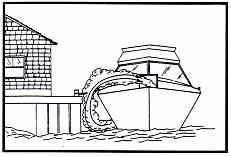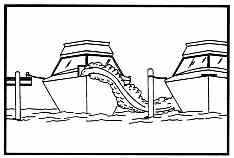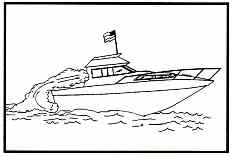Safety Information
Carbon Monoxide Poisoning—Warning Fact Sheet
Each year, boaters are injured or killed by carbon monoxide. Most occur on older boats, and within the cabin or other enclosed areas. Virtually all of the poisonings are preventable.
Carbon monoxide is a potentially deadly gas produced any time a carbon-based fuel, such as gasoline, propane, charcoal or oil burns. Sources on your boat include gasoline engines and generators, cooking ranges, space heaters and water heaters. Cold and poorly tuned engines produce more carbon monoxide than warm, properly tuned engines.
Carbon monoxide is colorless, odorless and tasteless, and mixes evenly with the air. It enters your blood stream through the lungs and displaces the oxygen your body needs. Early symptoms of carbon monoxide poisoning—irritated eyes, headache, nausea, weakness and dizziness—are often confused with seasickness. Prolonged exposure can lead to death.
Carbon monoxide can collect within a boat in a variety of ways. Exhaust leaks, the leading cause of death by carbon monoxide, can allow carbon monoxide to migrate throughout the boat and into enclosed areas. Even properly vented exhaust can re-enter a boat if it’s moored too close to a dock or another boat, or if the exhaust is pushed back by prevailing winds. Exhaust can also re-enter boats when cruising under certain conditions—the station wagon effect—especially with canvas in place.
Regular maintenance and proper operation of the boat are the best defenses against injury from carbon monoxide.
What To Do
- Schedule regular engine and exhaust system maintenance inspections by experienced and trained mechanics.
- Be aware that dangerous concentrations of carbon monoxide can accumulate when a boat, generator or other fueled device is operated while the boat is at a dock, seawall or alongside another boat. Do not run the boat or equipment for extended periods of time under these conditions, or without continuous monitoring.
- Keep forward facing hatches open to allow fresh air circulation in accommodation spaces, even in inclement weather. When possible, run the boat so that the prevailing winds will help dissipate the exhaust.
- Do not confuse carbon monoxide poisoning with seasickness or intoxication. If someone on-board complains of irritated eyes, headache, nausea, weakness or dizziness, immediately move the person to fresh air, investigate the cause and take corrective action. Seek medical attention, if necessary.
- Install a carbon monoxide detector in each accommodation space on your boat. Check the detectors periodically to be sure that are functioning properly.
Checklist
Each trip:
- Make sure all exhaust clamps are in place and secure.
- Look for exhaust leaking from the exhaust system components evidenced by rust and/or black streaking, water leaks, or corroded or cracked fittings.
- Inspect rubber exhaust hoses for burned or cracked sections. All rubber hoses should be pliable and free of kinks.
- Confirm that water flows from the exhaust outlet when the engines and generator are started.
- Listen for any change in exhaust sound which could indicate a failure of an exhaust component.
- Test the operation of each carbon monoxide detector by pressing the test button.[/list]
Do not operate the vessel if any of these problems exist.
At least annually: (Performed by a qualified marine technician)[list style=”checklist” color=”primary”]
- Replace exhaust hoses if any evidence of cracking, charring or deterioration is found.
- Replace each water pump impeller and inspect the condition of the water pump housing. Replace if worn. (Refer to the engine and generator manuals for further information.)
- Inspect each of the metallic exhaust components for cracking, rusting, leaking or looseness. Pay particular attention to the cylinder head, exhaust manifold, water injection elbow, and the threaded adapter nipple between the manifold and the elbow.
- Clean, inspect and confirm the proper operation of the generator cooling water anti-siphon valve (if equipped).[/list]
Warning
These Conditions May Cause Carbon Monoxide to Accumulate:
 Blockage of exhaust outlets can cause carbon monoxide to accumulate in the cabin and cockpit area — even when the hatches, windows, portholes and doors are closed.
Blockage of exhaust outlets can cause carbon monoxide to accumulate in the cabin and cockpit area — even when the hatches, windows, portholes and doors are closed.
[clear]
 Exhaust from another vessel while docked or anchored alongside your boat, can emit poisonous carbon monoxide gas inside the cabin and cockpit areas of your boat.
Exhaust from another vessel while docked or anchored alongside your boat, can emit poisonous carbon monoxide gas inside the cabin and cockpit areas of your boat.
[clear]
 The “station wagon effect” or backdrafting can cause carbon monoxide to accumulate inside the cabin, cockpit and bridge areas when operating the boat at a high bow angle or with improper or heavy loading.
The “station wagon effect” or backdrafting can cause carbon monoxide to accumulate inside the cabin, cockpit and bridge areas when operating the boat at a high bow angle or with improper or heavy loading.
[clear]
 The “station wagon effect” or backdrafting can also cause carbon monoxide to accumulate inside the cabin, cockpit and bridge areas when the boat is underway using protective weather coverings.
The “station wagon effect” or backdrafting can also cause carbon monoxide to accumulate inside the cabin, cockpit and bridge areas when the boat is underway using protective weather coverings.
[clear]
 Slow speeds or having boat stopped in the water can cause carbon monoxide gas to accumulate in the cabin, cockpit and bridge areas. A tail wind can also increase accumulation (force of wind entering from aft section of yacht.)
Slow speeds or having boat stopped in the water can cause carbon monoxide gas to accumulate in the cabin, cockpit and bridge areas. A tail wind can also increase accumulation (force of wind entering from aft section of yacht.)
[clear]
Information
To find out more information about how you can prevent carbon monoxide poisoning on recreational boats and other ways to make boating safer, contact:
United States Coast Guard
Office of Boating Safety
Headquarters G-NAB-6
2100 Second Street SW
Washington, DC 20593
www.uscgboating.org
757-441-3287
National Marine Manufacturers Association
200 East Randolph Drive
Suite 5100
Chicago, IL 60601-9301
www.nmma.org
312-946-6200
Boat U.S.
880 South Picket Street
Alexandria, VA 22304
www.boatus.com
703-823-9550
American Boat & Yacht Council, Inc.
3069 Solomon’s Island Road
Edgewater, MD 21037-1416
410-956-1050
www.abycinc.org
Boating Safety Awareness Series
A Public Service of the National Marine Manufacturers Association
Carbon Monoxide Poisoning Brochure (PDF)
Electrical Shock Hazards—Warning Fact Sheet
Each year swimmers, boaters and people in marinas are injured or killed by electrical accidents. These occur because of wiring problems, component failures or the use of improper equipment when bringing 120 volt or 120.240 volt AC shorepower on board boats. Virtually all of these accidents are avoidable.
While AC electrical power is potentially deadly in any location, it is especially dangerous in and around the water. If there is a problem with the marina wiring, your boat’s wiring or its shorepower cord, contacting concrete or metal docks or the water itself can cause electrical shock. Handling shorepower cords when you are barefoot increases the chance of being electrocuted.
Electricity cannot be detected without the use of specialized test equipment. It may be present on metallic objects such as marina electrical equipment and shorepower connectors or even in the water itself. Contact with electrically energized equipment may result in painful shock, burns, muscle contraction or paralysis, loss of breathing and even stopping of the heart.
Electricity may be present in the water in places where boats are connected to shorepower or where marina wiring is defective. Electricity in the water will generally paralyze swimmers to the point where they lose muscle control, cannot swim and then drown. In a few cases the electrical “field” has been strong enough to cause electrocution from cardiac arrest. The possibility of either of these occurring is greater in fresh than in salt water.
What To Do
- NEVER swim in a marina or in other areas where boats are connected to shorepower.
- Be sure shorepower cords and adapters are in good condition. When in doubt, replace them or have them repaired by a qualified marine electrician.
- Do not use “homemade” adapters or shorepower cords. Purchase and use only products that are “factory” assembled by a recognized manufacturer. Read and follow the manufacturer’s instructions and warnings.
- Always wear “rubber” soled shoes (such as deck shoes or tennis shoes) when handling electrical equipment. Try to avoid touching other metallic objects when working with shorepower cords.
- If a boat inspection or repair requires a person to be in the water, disconnect the boat and all nearby boats from shorepower. Before entering the water check the water for the presence of electricity with a voltmeter or other test equipment. [PHOTO]
Check List
When connecting to shorepower:[list style=”checklist” color=”primary”]
- Shorepower cords and adapters must be clean and dry before use. If they are dropped overboard, do not use until allowed to dry and then checked by a qualified marine electrician. Keep shorepower inlet covers tightly closed when not in use.
- Get permission from the marina before connecting to a dock receptacle and ask if the “polarity” and ground are correct and when they were last checked.
- Make certain there are no swimmers in the water around your slip.
- Before connecting the shorepower cord, turn off both the boat’s main AC circuit breaker and the dock breaker.
- Connect the shorepower cord at the boat first, then connect the cord to the dock receptacle and turn on the dock breaker.
- Check the boat’s “polarity” alarm or light (if it has one) on the AC panel as soon as the dock breaker is turned on. If the polarity is incorrect, shut the dock breaker off and disconnect the dock end of the shorepower cord immediately. Report the problem to the marina. The marina should contact a qualified electrician to make correction.[/list]
When disconnecting from shorepower:[list style=”checklist” color=”primary”]
- Shut off the boat’s main AC circuit breaker, then turn off the dock breaker. Disconnect the dock end of the shorepower cord first.
- Disconnect the shorepower cord at the boat receptacle.
- Clean and dry the shorepower cord. Store in a dry location on board the boat.[/list]
Once a year, have a qualified marina electrician perform the following:[list style=”checklist” color=”primary”]
- Verify the integrity of the boat’s entire AC shorepower grounding system, including the connection to the DC system negative.
- Verify that any galvanic isolators (if installed in your boat) meet current American Boat & Yacht Council (ABYC) standards and are fully functional.
- Inspect shorepower cords, adapters and boat receptacles for any signs of deterioration, including cord wear, loose connections, signs of sparking or overheating and bent or pitted blades. If there are any such signs, examine, correct and test the equipment or replace it.
- Operate the boat’s electrical system at full load (everything on) and check for AC system leakage or voltage between the boat’s underwater fittings (bonding system, if equipped) and the shoreside AC system ground.[/list]
Warning—Water and electricity do not mix!
Do not:[list style=”arrow4″ color=”primary”]
- Swim in marinas
- Alter shorepower connectors
- Use “homemade” adapters or cordsets
- Connect to a receptacle with a different configuration than the plug[/lists]
In the event of an in-water (or onboard) electrical accident:[list style=”arrow4″ color=”primary”]
- Turn off (or unplug) the power to all boats in the area immediately (only then is it safe for others to effect rescue)
- Remove the victim from the water
- Summon help
- If needed, begin rescue breathing or CPR (as appropriate)[/list]
Information
To find out more information about how to avoid electrical shock hazards on recreational boats and how to make boating safer, contact:
United States Coast Guard
Office of Boating Safety
Headquarters G-OPB-3
2100 Second Street SW
Washington, CD 20593
www.uscgboating.org
202-267-0988
American Boat & Yacht Council, Inc.
3069 Solomon’s Island Road
Edgewater, MD 21037-1416
www.abycinc.org
410-956-1050
National Fire Protection Association
One Batterymarch Park
Quincy, MA 02269-9101
617-770-3000
NFPA 70 (National Electrical Code);
Article 555 (Marinas and Boatyards)
NFPA 302 (Motorcraft)
NFPA 303 (Marinas and Boatyards)
National Marine Manufacturers Association
200 East Randolph Drive
Suite 5100
Chicago, IL 60601-6528
www.nmma.org
312-946-6200
Boating Safety Awareness Series
A Public Service of the National Marine Manufacturers Association



